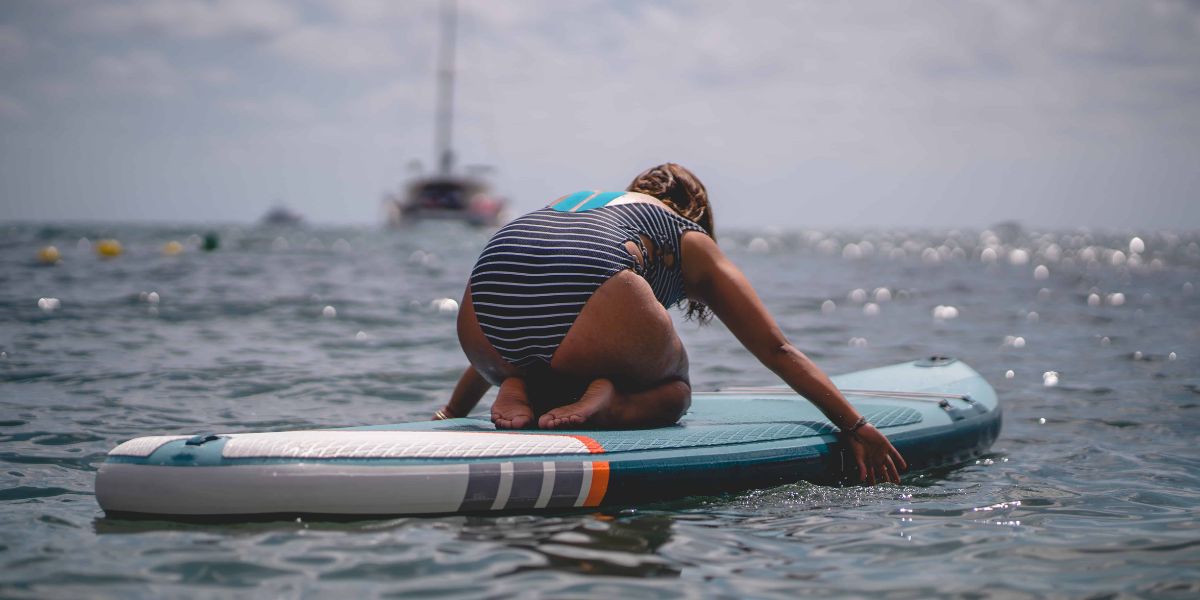Despite their popularity, a lot of people still have reservations about inflatable paddleboards. There’s something concerning about an inflatable item at sea that can just put people off.

But the truth is, it’s really hard to pop an inflatable paddleboard – as long as you’ve bought a quality one, and not a cheap thing for a few bucks from a store you can’t trust.
Inflatable paddleboards are manufactured to a high standard using thick materials that are often military-grade. This isn’t rubber like you’d find on a balloon, or even an air mattress – imagine something that’s as thick as leather.
It’s not just the material either, but the seams are tightly woven and properly sealed with airtight adhesive. The result is a paddleboard that can stand up to almost anything.
But the key word there is “almost”. They aren’t indestructible, especially if you don’t look after them properly. So let’s find out how you should best care for your inflatable paddleboard, and what to do if you do pop it.
How To Prevent Your Inflatable Paddleboard From Popping
While they are not easy to pop, inflatable paddleboards still need to be cared for. Here’s how to make sure your inflatable paddleboard survives for all your upcoming trips to the lake or ocean.
1. Protect It From Sunlight
The sun can have two negative impacts on your SUP paddleboard. Firstly, UV light can weaken the material with excessive exposure – the rays will soften the material. And secondly, the heat from the sun can slightly warp the paddleboard, or even cause an inflated paddleboard to expand.
Always make sure to deflate your paddleboard when you aren’t using it, and store it in a cool, dark place until you’re ready to use it again.

2. Avoid Overinflating
Overinflating your inflatable SUP will put pressure on the seams and valves, causing them to weaken. To avoid this, check the manufacturer’s recommended psi, and don’t exceed it. It’s usually 15 psi for most inflatables.
Fortunately, it’s not easy to overinflate a paddleboard, especially with a manual pump – you’ll be worn out before you can exceed the recommended psi. Electric pumps also have features that prevent them from inflating past a certain psi.
However, it is easy to overinflate using an air compressor, so you might want to avoid that.
3. Avoid Paddling Near Sharp Objects
It may seem obvious, but one of the most common causes of popped paddleboards is sharp objects in the sea. This could be rocks, or in shallow waters, it might be trash or coral.
So always check where you’re planning to paddle, ensuring it’s not too shallow and that you don’t have any sharp obstacles in your path.

4. Store your inflatable paddleboard carefully
One of the major benefits of inflatable paddleboards is that you can deflate them, fold them, and store them in a small space.
However, the way you store your paddleboard could expose it to wear and tear, which will weaken the board, increasing its likelihood of popping.
First, make sure that it’s clean and dry before storing it in an equally clean and dry place. Inspect the storage area for any sharp objects that could make a cut through the fabric. And if you’re storing it somewhere that critters can get into, make sure it’s elevated and ideally inside a container.
Many blow up paddleboards come with a storage bag, like this one.
Lastly, don’t stack anything on top of the deflated board.
5. Don’t Drag Your Paddleboard
While inflatable paddleboards are pretty robust, that doesn’t mean you can be careless. So don’t drag it over the beach where there could be pebbles or even rough sand that could damage the surface.
They’re light enough to carry, so make sure you lift it until you reach the water.
6. Choose A Dog-Friendly Paddboard When Paddling With A Pooch
If you’re considering investing in a paddle board so you can bring your furry friend along, it’s important to make sure you choose a dog-friendly paddle board that can withstand the wear and tear that comes with having a dog on board.
Not all inflatable paddle boards are created equal and a regular inflatable paddle board is not designed to withstand the sharp claws of a dog.
It’s important to choose a board that is specifically designed to be dog-friendly, with reinforced seams and extra layers of material to prevent punctures.
Another benefit of a dog-friendly paddle board is that it will typically have a more stable and wider design, which can help keep you and your dog from falling in the water. Additionally, dog-friendly boards often have non-slip surfaces to help keep your pup from slipping and sliding around on the board.
Durable 11-foot paddle board
Padded area designed for dogs
Includes essential accessories
Read more: Will A Dog Pop An Inflatable Paddle Board?
What To Do When An Inflatable Paddleboard Pops?
If your paddleboard does develop a leak, here’s how to fix it:
1. Find The Leak
The first thing you have to do is find the leak, if it’s not obvious. Use a mix of water and dish soap, and spray it onto the inflated board (or use a sponge). When you can see bubbles forming, you’ve found the leak.
2. Clean The Area
You can’t apply a patch to a dirty board, so wipe it clean to remove any grease or grime. Allow it to fully dry before you carry on with the repair.
3. Sandpaper The Patch And Board
You should lightly sandpaper the board where the hole is, and the patch from the repair kit. This roughs up the surface and ensures that the glue will stick better.
If the leak is coming from the valve, read this guide on how to fix it.
4. Glue The Patch In Place
Apply glue to the patch, and wait a minute for it to become tacky. Apply more glue, wait another minute, then stick it onto the paddleboard. Make sure the patch is round – square patches tend to weaken at the corners.
When it’s in place, place a heavy item onto the patch and leave it for at least an hour before you inflate the paddleboard. Ideally, leave it overnight to fully bond.
Always make sure you use the adhesive included in your repair kit. This is designed to be waterproof and airtight. Superglue can sometimes damage the material, so don’t assume it’s a good replacement.
Easy to use
Suitable for repairing inflatables
Made of safe PVC
Sturdy, durable, and waterproof
Final Thoughts
As long as you look after your inflatable paddleboard, it’s likely that you’ll get bored of using it long before it pops.
However, even with the best intentions and care, sometimes accidents happen. And if they do, just make sure to use the patch to fix it using the steps above. If you don’t have a patch, buy a proper inflatable boat or paddleboard repair kit, so that you know you’re getting the right materials for the job.



